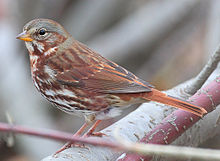Red fox sparrow
| Red fox sparrow | |
|---|---|

| |
| Probable eastern fox sparrow Passerella iliaca iliaca | |
| Scientific classification | |
| Domain: | Eukaryota |
| Kingdom: | Animalia |
| Phylum: | Chordata |
| Class: | Aves |
| Order: | Passeriformes |
| Family: | Passerellidae |
| Genus: | Passerella |
| Species: | P. iliaca |
| Subspecies: | P. i. iliaca
|
| Trinomial name | |
| Passerella iliaca iliaca (Merrem, 1786)
| |

| |
| Breeding ranges of the four fox sparrow groups | |
Red fox sparrow is the collective name for the most brightly colored
Taxonomy
Pending wider-spread acceptance of species status, the red fox sparrow is currently classified as a "subspecies group"[2] within fox sparrows.
It has long been suspected to be a separate
Description


The red fox sparrow is a large sparrow with a length of 15–19 cm (6–7.5 in), wingspan of 27 cm (11 in) and an average weight of 32 grams (1.1 ounces).[7][8] The head is gray with a rufus crown auriculars or ear coverts. Throat is white with a rufus lateral stripe on each side. The lower bill is yellow while the top transitions from yellow at the bottom to black at the top. The breast has reddish brown streaks with a messy central spot. The streaks continue down the flanks but the belly is generally white. The combination of distinct rufus and gray streaks on the back with a gray rump is diagnostic. Sexes are morphologically similar.
Vocalization
Its voice is described as "a loud smack like Brown Thrasher".[8]
Behavior
Reproduction
Red fox sparrows breed in a wide band that stretches through mostly taiga habitat, from Newfoundland to northern Alaska. Their preferred breeding habitats are dense willow and alder thickets as well as spruce and fir bogs.
Red fox sparrows may nest on the ground, or in shrubs and trees. They typically nest less than 2 metres off the ground.
Wintering and migration
They winter in
Ranges and geographic variation
Geographic variation in the iliaca subspecies group is minor compared to individual variation, both in morphology and molecular data samples.
However, the populations occupy different ranges, apparently—as far as they can be distinguished—with just a small band of overlap. The contact zone is roughly the area between the Nelson and lower Churchill Rivers, Manitoba, in summer. In winter, the Mississippi River and the US states of Alabama and Georgia mark the approximate boundary between the subspecies' ranges. P. i. iliaca occurs from S Wisconsin and Ontario east to Massachusetts and then along the coast north to southern Canada; it ranges south to the Gulf of Mexico and N Florida, whereas P. i. zaboria occurs from SE Minnesota to the Great Plains, south to Texas and east to the zone of overlap mentioned above.[15]
References
- ^ "Fox Sparrow (Red)". Retrieved 2022-09-15.
- ^ Not defined by the ICZN
- ^ Swarth H.W. (1920). "Revision of the avian genus Passerella with special reference to the distribution and migration of the races in California". University of California Publications in Zoology. 21: 75–224.
- ^ PMID 28567786.
- ^ Zink, Robert M.; Kessen, A.E. (1999). "Species Limits in the Fox Sparrow". Birding. 31: 508–517.
- ^ Kilgore, S (2002). "Passerella iliaca". Animal Diversity Web. University of Michigan Museum of Zoology. Retrieved 2008-04-15.
- ^ ISBN 0-679-45122-6.
- ^ Erin Koran, E; Super, P (2008). "Passerella iliaca". NatureServe Explorer: An encyclopedia of Life. NatureServe. Retrieved 2008-04-22.
- ^ ISBN 0-394-46651-9.
- ^ "Passerella iliaca". Discover Life in America. 2008. Archived from the original on 2007-07-02. Retrieved 2008-04-22.
- Wilson Bulletin. 18 (2): 47–60.
- ^ Ohio Ornithological Society (2004): Annotated Ohio state checklist Archived 2004-07-18 at the Wayback Machine.
- ISBN 0-691-11747-0p. 185
- doi:10.2173/bna.715(requires subscription)

